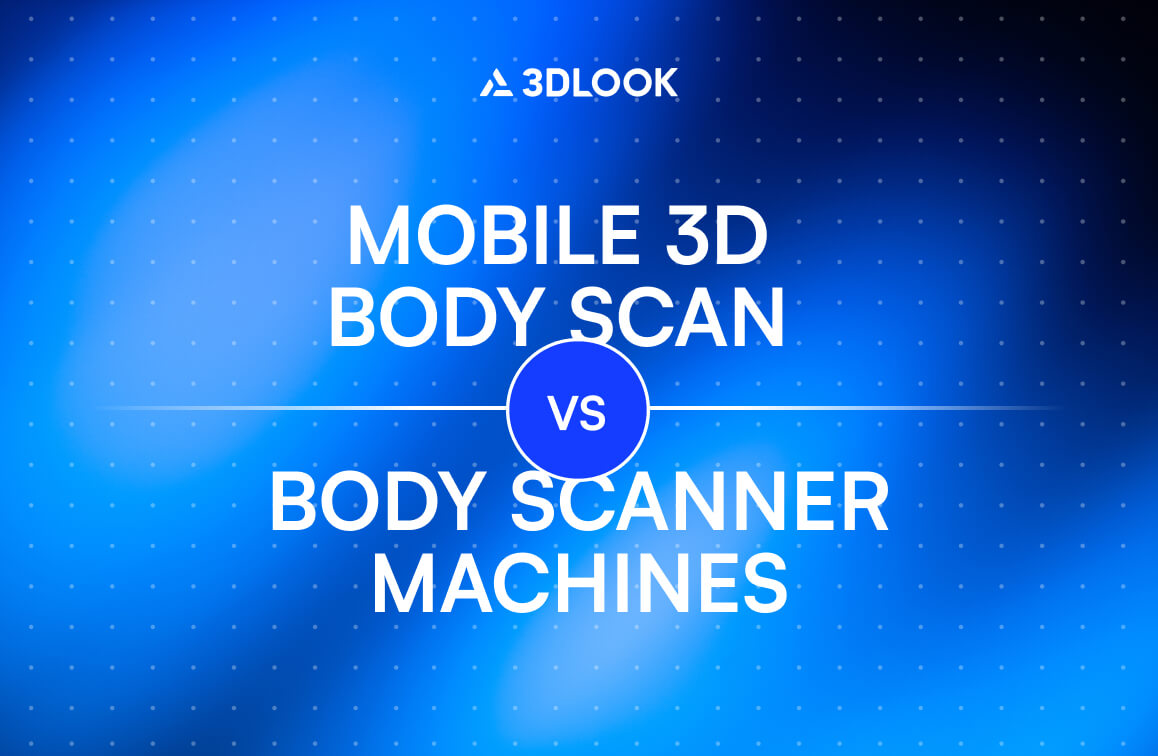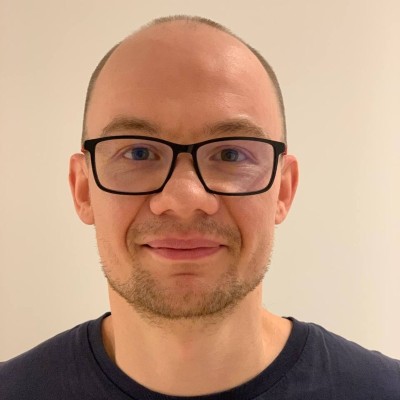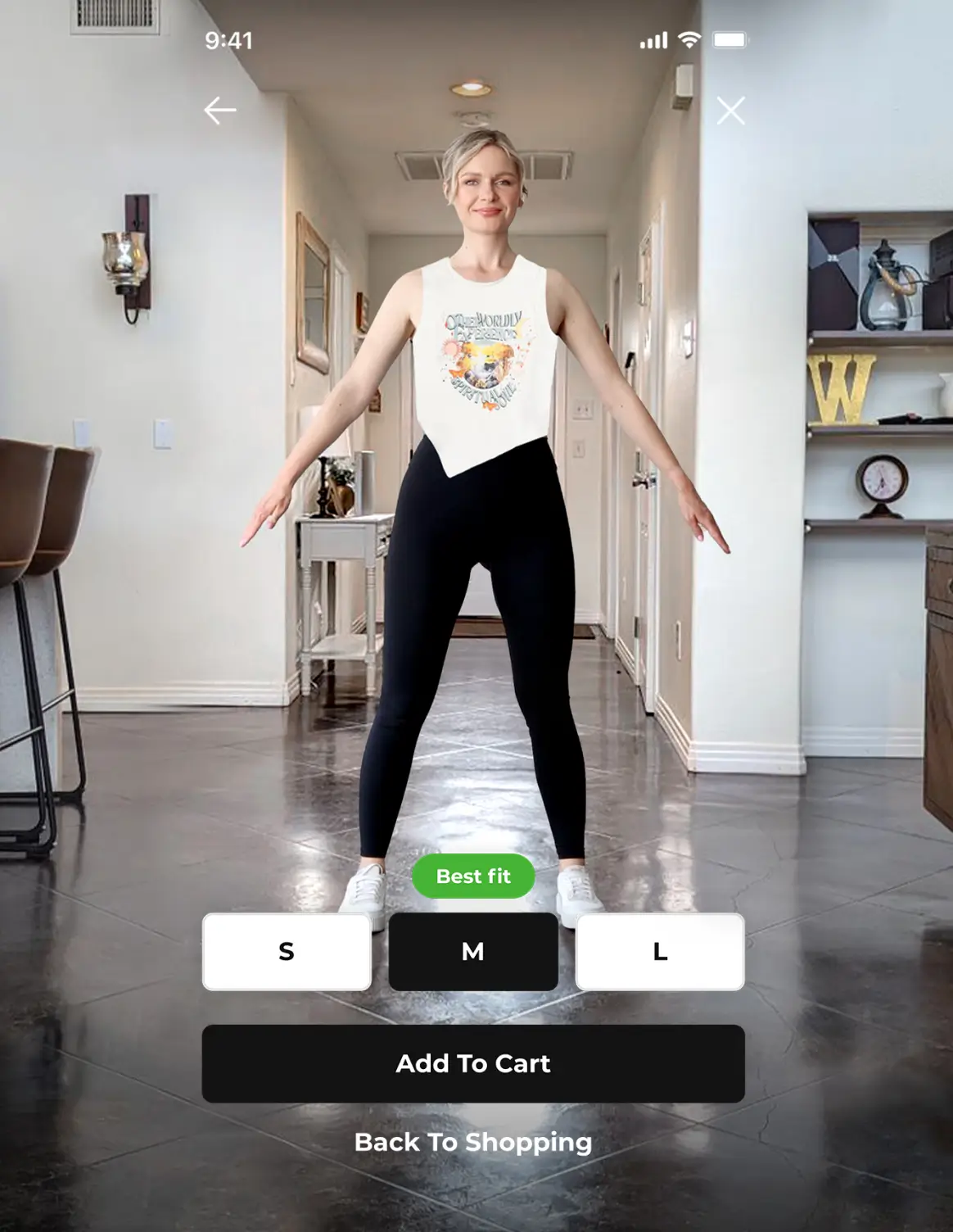In today’s digital-first world, the ability to capture precise body measurements has transformed industries from fitness and healthcare to weight loss programs and telehealth services. At 3DLook, our mission centers on democratizing access to accurate body data through innovative mobile technology. As the market evolves, a pivotal question emerges: How does mobile 3D body scan compares to traditional body scanner machines, and what does this mean for the industry?
The ability to measure and visualize physical changes over time has become fundamental to effective health and wellness interventions in both in-person and virtual care settings. Let’s explore the technological landscape, compare capabilities, and examine the implications for professionals navigating this rapidly evolving space.
Technology Overview
3D Body Scan Apps: Accessibility Meets Innovation
Mobile body scanning apps like 3DLook’s solutions leverage everyday technology to deliver extraordinary results. Our approach combines smartphone camera capture with sophisticated AI-powered algorithms that transform simple 2D images into accurate 3D models. The cloud processing infrastructure handles complex calculations without taxing the user’s device, while our proprietary landmark detection technology identifies and maps key body points for enhanced measurement accuracy.
The powerful measurement tool is accessible anywhere and anytime. Weight loss programs now track circumference measurements alongside scale weight, providing clients with more comprehensive progress metrics. Telehealth providers can remotely assess physical changes that might otherwise require in-person visits. Fitness professionals monitor client progress between sessions, while nutritionists correlate dietary changes with measurable physical outcomes.
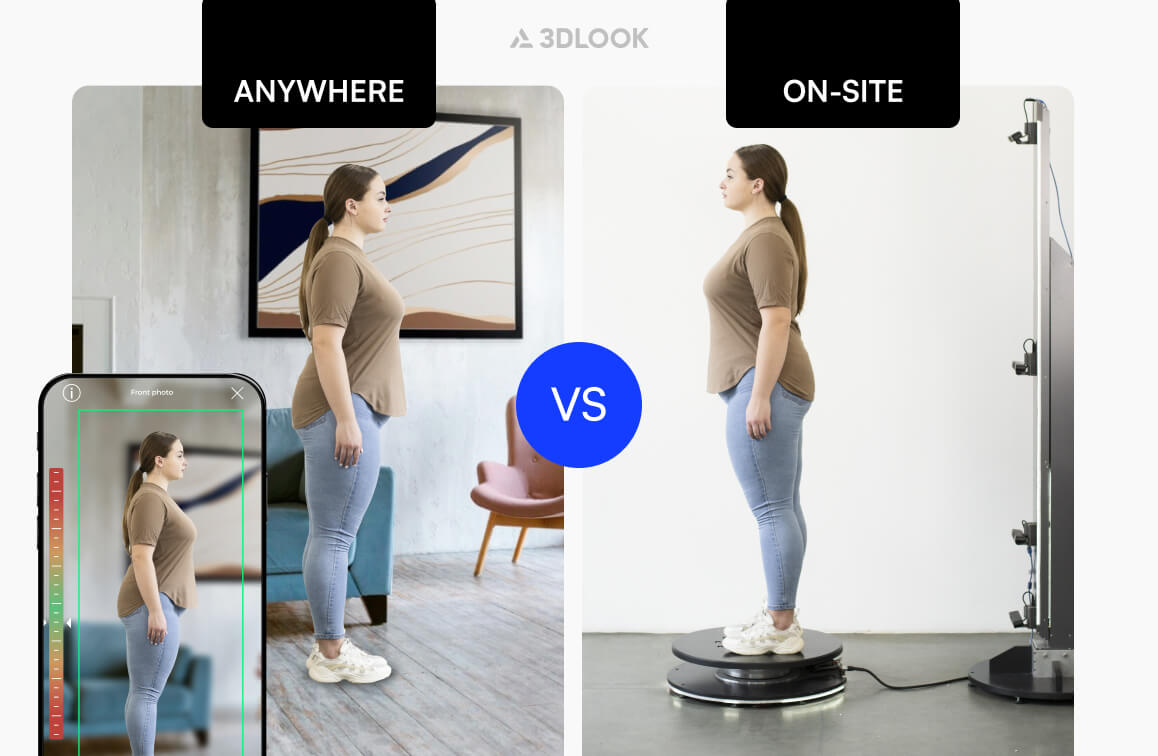
Body Scanner Machines: Hardware-Based Precision
Traditional body scanner machines represent the legacy approach to body measurement with their dedicated hardware installations, multiple sensor arrays, high-precision mechanics, and on-premises processing requirements. These purpose-built scanning booths with fixed dimensions rely on depth cameras, structured light projectors, or laser systems calibrated for laboratory-grade accuracy.
These systems typically serve specialized environments like medical clinics, research facilities, and fitness assessment centers where controlled conditions can be maintained. While they provide detailed data, their limited availability makes consistent tracking challenging for most health and fitness consumers who cannot access these facilities on a regular basis. This limitation is particularly problematic for telehealth services and virtual weight loss programs that serve clients across wide geographic areas.
Accuracy & Reliability
Mobile Scanning Technology’s Rapid Evolution
Recent validation research has shown promising results for mobile 3D body scanning applications. Studies demonstrate that smartphone-based scanning apps can achieve accuracy levels comparable to professional 3D optical systems. For instance, research published in the European Journal of Clinical Nutrition found that mobile device-compatible scanners achieved measurement precision within clinically acceptable ranges.
3DLook’s mobile scanning technology has undergone remarkable advancement in recent years. Our internal validation studies show measurement accuracy within 1.5-2.2 cm for most body measurements—a threshold that meets or exceeds the requirements for most commercial applications.
Key factors driving our accuracy improvements include:
- Larger and more diverse training datasets
- Enhanced pose estimation algorithms
- Continuous feedback loops with enterprise clients
Hardware Scanner Precision
Traditional body scanners still maintain advantages in certain precision metrics:
- Sub-millimeter accuracy for specialized applications
- More consistent results in controlled environments
- Greater point cloud density for surface topology
Research from the Plastic and Reconstructive Surgery journal confirms that professional 3D scanners can achieve mean absolute errors as low as 0.62 ± 0.28 mm in controlled settings.
However, this precision comes with significant trade-offs in terms of accessibility, cost, and deployment flexibility.
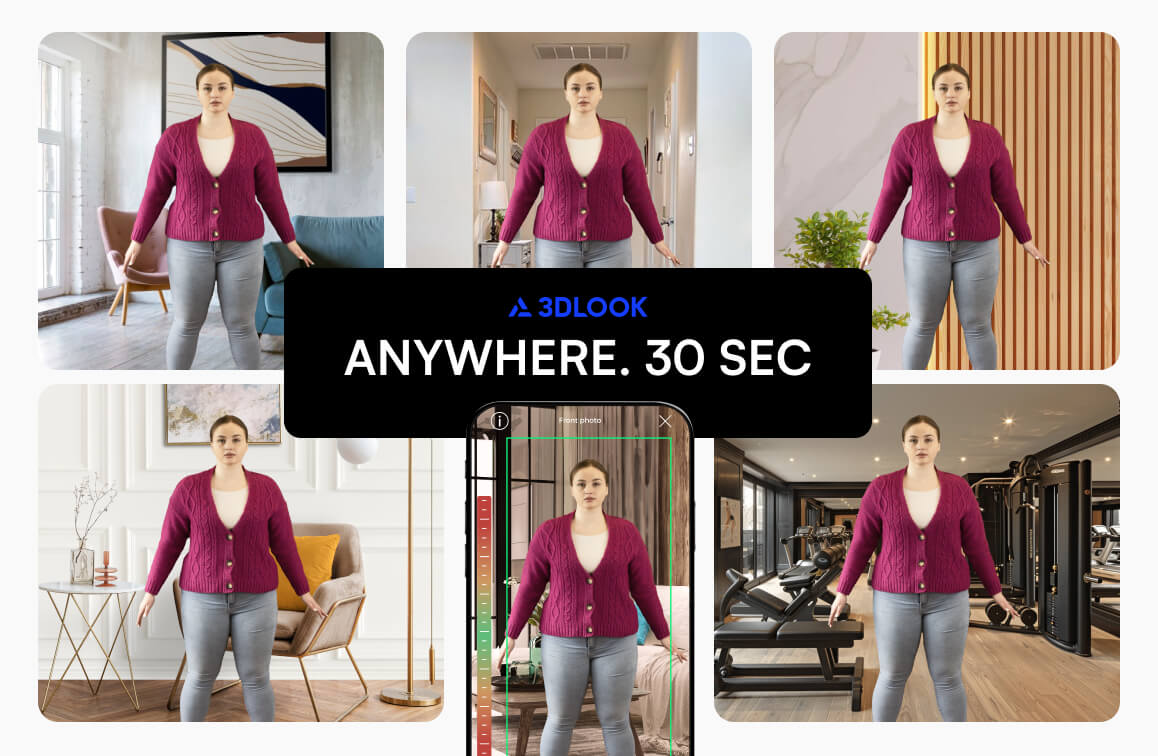
Key Comparison Areas
User Experience & Accessibility
The Mobile Advantage: Scanning Anywhere
3DLook’s approach fundamentally transforms the user experience in the health, fitness, and weight management space. Users can scan in their own homes using familiar smartphone technology, completing the entire process in under 30 seconds. Results are available instantly, which significantly enhances client engagement and program adherence. This accessibility has profound implications across multiple health sectors.
The telehealth market has experienced explosive growth, with usage increasing from 15.4% to 86.5% among physicians from 2019 to 2021 and the global market projected to reach USD 1,046.96 billion by 2034.
Weight loss programs have experienced particular benefits from mobile scanning technology. The psychological impact of seeing measurable changes in waist, hip, and other circumference measurements provides powerful motivation during weight plateaus—when scale numbers temporarily stall but body composition continues to improve.
Fitness professionals can now receive consistent measurement data between in-person sessions, helping them adjust programs based on actual results. Wellness coaches support clients in remote locations previously underserved by advanced body composition technology.
The psychological benefits extend beyond convenience—many individuals feel uncomfortable being measured in person, particularly those just beginning their weight loss journey. The privacy of self-scanning removes this barrier to engagement, allowing more people to benefit from body composition monitoring.
Our API architecture enabling seamless incorporation of measurement data into virtual care platforms. This integration allows measurement results to appear alongside other health metrics in patient dashboards, creating a more comprehensive picture of health status for both patients and providers.
The Machine Experience: Controlled but Constrained
Traditional scanners offer a different experience that presents significant barriers, particularly in telehealth and virtual weight management contexts. Users must visit specific locations with controlled lighting and positioning, often requiring appointments that disrupt already busy schedules. Many users report discomfort with booth-style scanning, creating a psychological barrier to regular monitoring.
For telehealth services, the requirement for physical presence fundamentally undermines the remote care model. When working with bariatric patients or those with mobility limitations, traditional scanning becomes practically impossible for regular monitoring. Weight loss programs struggle to maintain consistent measurement protocols across geographic regions where scanning technology availability varies dramatically.
For fitness centers that invest in these machines, the geographic constraints and appointment-based access severely limit their utility for member engagement. The inability to track members between visits represents a missed opportunity for demonstrating value and progress, which directly impacts retention and program success rates.
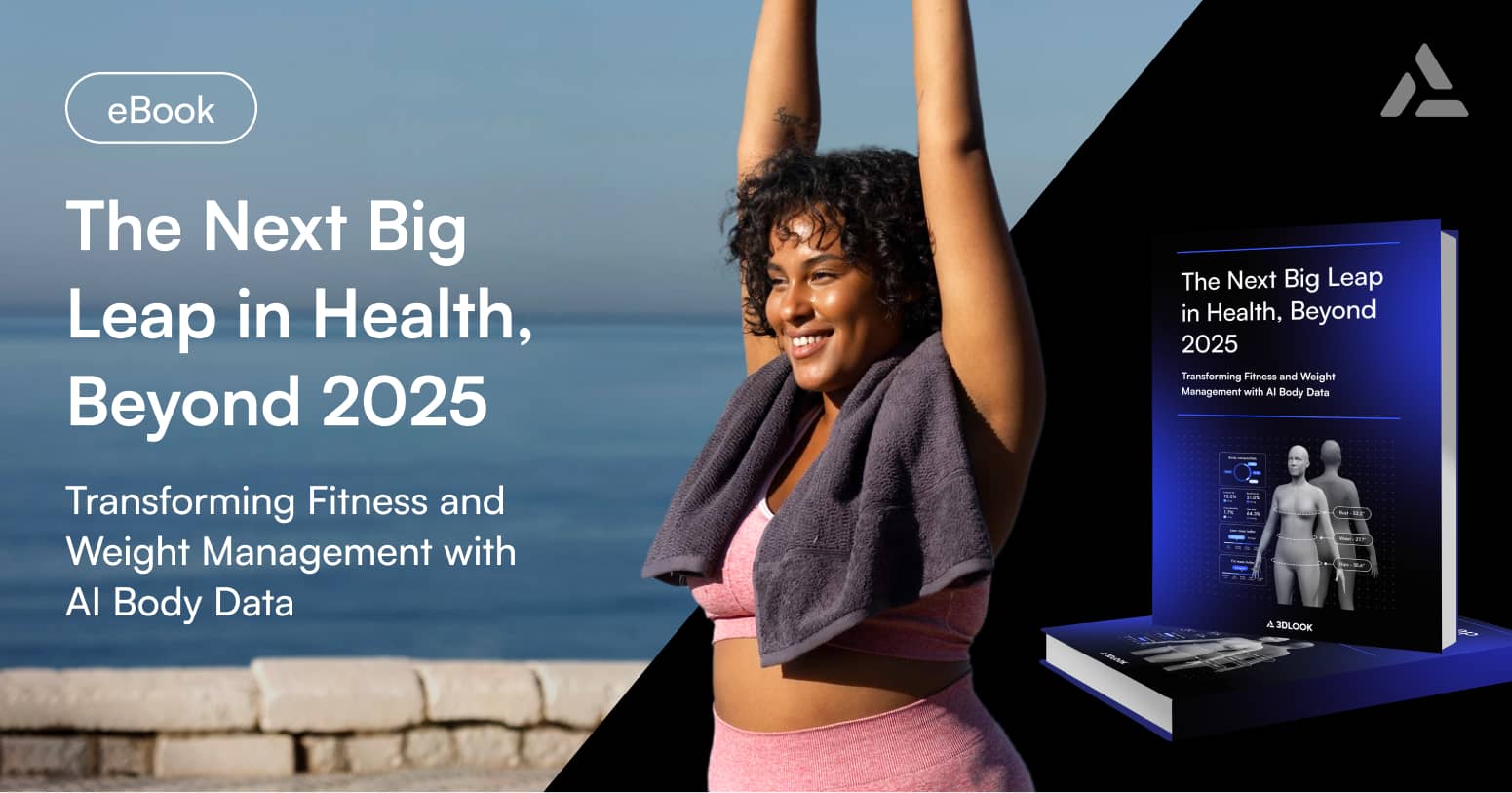
Discover how AI-powered body data is revolutionizing health, fitness, and weight management, setting a new standard for personalization and progress tracking.
Comparative Strengths and Limitations
The convergence of mobile 3D scanning technology with the expanding telehealth market presents unprecedented opportunities. McKinsey research indicates that up to $250 billion of current US healthcare spend could potentially be virtualized, with telehealth utilization increasing 38 times from pre-COVID-19 baselines.
While traditional scanning booths excel in controlled environments with their sub-millimeter measurement capacity, they require substantial initial investments. Their physical presence necessitates dedicated space and staff training, limiting deployment to specialized facilities. Scan times typically range from 1-5 minutes, not including preparation time and travel to the facility—a significant barrier for telehealth and virtual weight management applications.
In contrast, 3DLook’s mobile scanning solutions operate on a subscription model that eliminates upfront hardware costs. Our technology delivers accuracy within 3 cm for most measurements—sufficient for the vast majority of telehealth, weight loss monitoring, and fitness applications. Scans complete in approximately 30 seconds using the smartphones clients already own, enabling private, at-home measurement experiences that remove barriers to regular tracking.
Mobile Economics: Democratic Access
The economic model of mobile scanning creates unprecedented opportunities:
- Low Entry Barrier: No hardware investment for end users
- Subscription Models: Flexible enterprise pricing aligned with actual usage
- Infinite Scalability: New users can be added without physical infrastructure
- Global Deployment: Launch in new markets without equipment shipping
- Rapid Iteration: Software updates deliver continuous improvement without hardware replacement
For enterprise clients, this translates to predictable costs and the ability to scale services dynamically with demand. The body fat measurement market is projected to reach USD 1,587.81 billion by 2034, with North America holding 35% market share, driven by increasing focus on preventive healthcare and rising obesity rates.
Machine Economics: Capital Intensive
Traditional scanner economics present more challenges:
- High Upfront Investment: $10,000-$200,000+ per installation
- Maintenance Costs: Ongoing calibration and service requirements
- Physical Space Requirements: Dedicated floor space with specific requirements
- Limited Throughput: Physical constraints on the number of users per day
These factors create significant obstacles for widespread deployment, particularly in emerging markets.
Hardware-based systems maintain advantages in specific health and medical contexts that require extraordinary precision. Clinical research settings use these systems when establishing baseline measurements for studies requiring standardized conditions across multiple research sites. Specialized medical applications like prosthetics design benefit from sub-millimeter accuracy for proper fit and function.
Elite sports performance centers continue to utilize booth scanners for their consistency in controlled environments, particularly when integrating with other measurement systems. Medical diagnostics requiring precise volumetric assessment also rely on these systems, especially when evaluating conditions affecting body symmetry or composition at a highly detailed level.
The trajectory of both technologies suggests profound implications for health, weight management, and telehealth applications.
Final Thoughts
While hardware-based solutions maintain advantages in specialized clinical environments, mobile solutions like 3DLook’s are revolutionizing how weight loss coaches, telehealth providers, fitness professionals, and individuals approach body measurement and progress tracking.
Mobile scanning has transcended the “good enough” threshold to become the preferred solution for most health and wellness applications. The combination of accessibility, frequency of measurement, and contextual data integration creates value that traditional systems simply cannot match.
